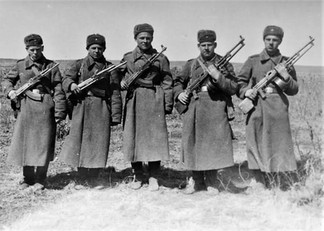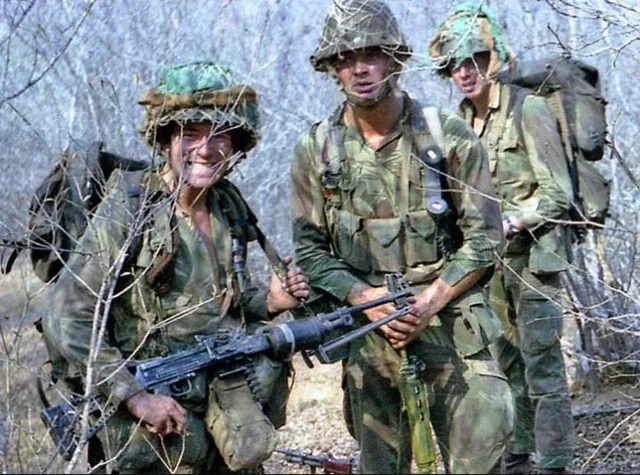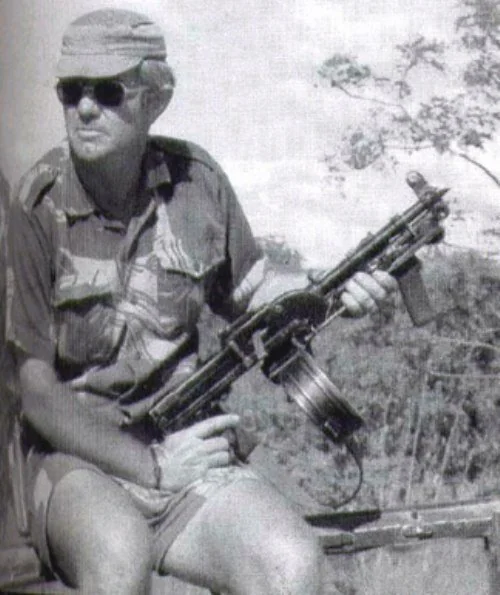Soviet small arms of the post-WW2 era are a fascinating subject. In a way, Soviet gun designers have created weapons that were way ahead of the time, which ultimately led to their decline and future rearmament. All this is discussed in detail in our book - Soviet Weapons of the Atomic Age.
In this article we will focus on just one weapon from the long list - the squad machine gun, RPD.

RPD development history
This machine gun is a combination of ideas and situational developments. In its core it just like every other weapon developed by Degtyarev - with its positives and negatives associated with this mechanical system. A long stroke gas system operates a bolt with two side-mounted locking flaps.
Interestingly, following the traditions, first version of RPD were actually presented with the pan magazine on top. It was much smaller than one on DP-27, due to new caliber - 7.62x39mm. But even then, this was a very archaic solution that could not work for a new generation of small arms.

A belt feed system was introduced. It was not invented by Degtyarev, but instead by couple of his colleagues back in 1942. The design of ammunition links and the general structure of the mechanism of the system was first employed in a very curios weapon, called LAD. This was a belt-fed machine gun using pistol ammunition - 7.62x25mm TT. This weapon was not successful. No significant advantages against PPSh-41 were noticed during the trials. But thanks to Degtyarev, the work was not lost, at least partially.

The adaption of RPD followed a similar path as AK. Initially submitted as a "light assault machine gun", it was quickly realized that the best role for it is to replace the DP-27 as a section machine gun. It was officially adapted by the Soviet Army on 18th of June, 1949, alongside with AK and SKS.

Problems and challenges
The RPD was not without its share of problems, which appeared on every stage of its development and practical use. The automation of the weapon was generally fine, as it was well tested on all previous machine guns designed by the same author. The problems appeared with the ammunition links. The ammunition came separately from the links and there was no machine to load it - it had to be done by hands. When not loaded correctly and uniformly, RPD tend to had stoppages.
The Soviet Army was also not fully satisfied with the machine gun for more common reasons. The RPD was seen as too heavy and hence not maneuverable enough. After all, it was a section level weapon, supposed to be used in close quarter combat if necessary.
Use around the world
While never used by the country of origin, at least on large scale, RPD gained significant popularity across the world. The was a long list of reason for such popularity. It was a powerful and modern weapon, that used handy ammunition which was becoming more common at the time. But more importantly, it was supplied to allies and satellites of the Soviet Union mostly for free. This lead to incredibly wide spread of the machine gun, effectively employed in most conflicts of the Cold War and beyond, often turning against the Soviet and then RusFed forces themselves.

The RPD, being the only weapon of it's class until 1980s, was particularly popular in Vietnam and Rhodesia. Used not only by those who was issued the weapon initially, but by the opposite forces, who captured some of these machine guns. US Special Forces and Rhodesian SAS were very fond of the weapon - it could provide a comparable firepower to M60 and FN MAG at close ranges at a fraction of weight.
Lastly, the RPD has reappeared in 2023 in the largest conflict since the Second World War. Russian occupational forces, struggling with the lack of modern belt fed machine guns, such as PKM and Pecheneg, had to pull out the old RPD from storage and issue to the front-line assault units.
However, this practice did not hold for long, allegedly due to problems with supply - modern Russian Army mainly uses 5.45mm ammunition and getting a hold of old 7.62x39 is a bit of a challenge.
Comparison with other machine guns
The RPD could not be compared to any other machine gun of the same era - simply because there were no similar systems. Other countries did not come to the intermediate cartridge until 1960s and belt fed machine guns for this caliber only really started to appear in 1970s. By this time, RPD was almost completely gone from the Soviet Army. So, it had to be compared to those that were actually used at the time. In the Soviet system of arms there was RP-46. A very powerful belt-fed weapon, that could deliver a lot of firepower due to heavy barrel. But it was not as maneuverable, because the ammunition box was not attached to the machine gun and had to be carried separately. By late 50s, Kalashnikov's team developed RPK. This was a good solution for the realities of the Soviet system which craved unification. At the same time, RPK could not deliver as much firepower as RPD, but was lighter and simpler to use. We have a separate article covering the story and comparison of the two.

Regarding the weapons of the opposite side, RPD had no direct competitors until the introduction of Minimi. Before that, NATO countries did not have a common belt-fed light machine gun, spare MG-3. Like RP-46, this machine gun was not best fitted for the same role as RPD.

















































Commenti